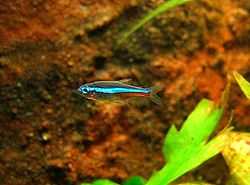Green neon tetra
| Green neon tetra | |
|---|---|
 | |
| Scientific classification | |
| Kingdom: | Animalia |
| Phylum: | Chordata |
| Class: | Actinopterygii |
| Order: | Characiformes |
| Family: | Characidae |
| Genus: | Paracheirodon |
| Species: | P. simulans |
| Binomial name | |
| Paracheirodon simulans (Géry, 1963)[1] | |
The green neon tetra (Paracheirodon simulans) is a freshwater fish of the Characidae family of order Characiformes. It is native to the upper Orinoco and Negro Rivers in South America.[2]
This fish is similar in appearance to the closely related and better-known neon tetra, but it is slightly smaller, and its red patch is less pronounced, while the blue-green areas of the upper body are more brilliant. Also, its body is slimmer than that of the neon tetra. It grows to a maximum overall length of about 3.5 cm (1.4 in).
Like the other Paracheirodon species, the green neon tetra is kept as an aquarium fish, but it is less commonly seen than either the neon tetra or the cardinal tetra.
P. simulans is also sometimes called the blue or false neon. Hyphessobrycon simulans and Cheirodon simulans are obsolete synonyms.
This fish loses its brilliant blue and red colors when lights are switched off, but regains them when lights are switched on again. The green neon tetra comes from extremely soft, acidic water at temperatures around 24 to 29°C (75-81°F).
Breeding
For breeding, these tetras need water similar to the waters in which they live in the wild; extremely soft water with a pH of about 6 and a temperature of around 77°F (25°C). Ideally, the water should be highly stained by the tannins from peat, in subdued light, shaded by plants. It spawns in a school, although in the actual act of spawning, one female may be closely associated with one or more males.
About 130 eggs can be laid by each female. The parents should be removed after spawning. The eggs should hatch in 24 hours. The eggs are light sensitive so avoid light. The babies are very small, so feeding infusoria (protozoa) is necessary early on. As they grow, this can increasingly be supplemented with fine commercial fry foods. Adults can breed again after a few weeks.
See also
References
- ↑ "Paracheirodon simulans". Integrated Taxonomic Information System. Retrieved December 15, 2004.
- ↑ Froese, Rainer and Pauly, Daniel, eds. (2004). "Paracheirodon simulans" in FishBase. October 2004 version.